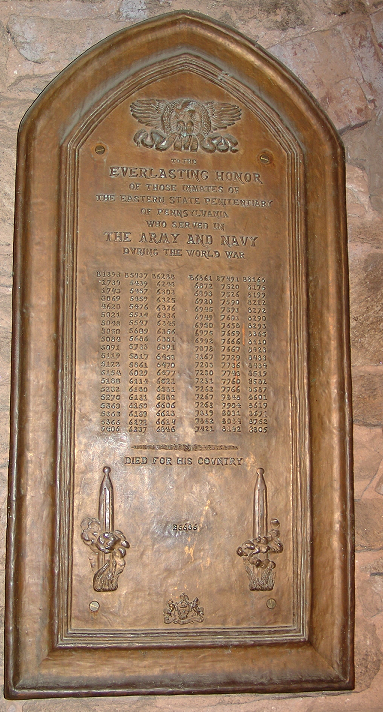When the United States officially entered World War I in April 1917, free men and women weren't the only ones who wanted to help their country. Unable to enlist in the military, prisoners at Philadelphia's Eastern State Penitentiary (ESP) did their part behind bars.
 The entrance to Eastern State Penitentiary at 2027 Fairmount Avenue in Philadelphia. The prison operated from 1829 until 1971. Photo courtesy of https://engagingplaces.net
The entrance to Eastern State Penitentiary at 2027 Fairmount Avenue in Philadelphia. The prison operated from 1829 until 1971. Photo courtesy of https://engagingplaces.netArticles in the prison newspaper, The Umpire, kept track of the inmates' efforts. According to a piece published on September 25, 1918, inmates raised $1600 in less than three hours to purchase an ambulance for the Red Cross. ESP's small number of female inmates contributed approximately $5 each, an especially astounding amount when considering the fact that prisoners only made about $8 per month. This contribution from the female inmates led The Umpire to conclude that, "the female species is a better fighter than the Male, else why so anxious to finance a fight?"
As The Umpire noted, raising funds for an ambulance was just one of many efforts undertaken by the inmates on behalf of the war effort. The paper also reported that, "We have bought Bonds and Stamps, given liberally to Red Cross; Y.M.C.A.; Boy Scouts, and nearly $4000 to the War Chest. We have rolled bandages, picked oakum, knitted socks, etc, tried in many ways to serve."
While celebrating these efforts, the article added that this type of work was certainly not the inmates' first choice:

I imagine that there was some national discussion about registering prisoners for the WWI draft, but unfortunately I haven't been able to find any related sources. In any case, those who were serving time at ESP during the war were not allowed to enlist. For the formally incarcerated, however, it was a different story.
Former Inmates Take Up Arms
Having served their time, many former Eastern State inmates did fight in World War I. This plaque, which still lives on the walls of Eastern State, celebrates those who served in the war.

Photo courtesy of https://wwionline.org/articles/prisoners-make-good-front/#1
The plaque was dedicated in 1922 in the presence of Philadelphia Major J. Hampton Moore and Congressman J. Washington Logue.
Unfortunately, however, the plaque only identifies the former inmates by number. Even when they're being celebrated, and even when they're no longer incarcerated, imprisonment erases identities. We will likely never know most of these veterans' names.
Sources:
"Prisoners Make Good at the Front." WWIOnline. https://wwionline.org/articles/prisoners-make-good-front/#12.
This is interesting- Every time I've seen that plaque it's struck me as kind of dehumanizing. But I never realized that other folks incarcerated there had done civilian war work. I wonder how the situation differed in comparison with other wars?
Good thought! Also, @tmaust just let me know that someone recently put together the identities of the prisoners from the plaque!
Great post! And a good reminder of the agency and generosity that incarcerated people still have, especially given ongoing debates about the prison industrial complex.
Absolutely! I should've hit that point harder.
Some nice twists here. Makes me want more of the back story.
This is a fantastic angle on history. Thank you for telling the story of these inmates. And welcome to Steemit! :)